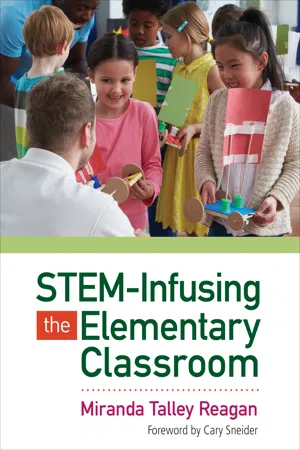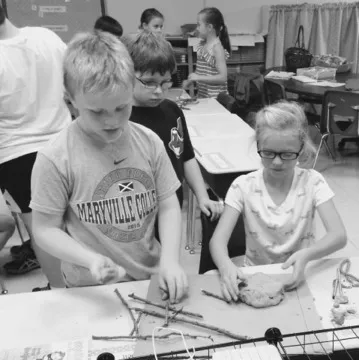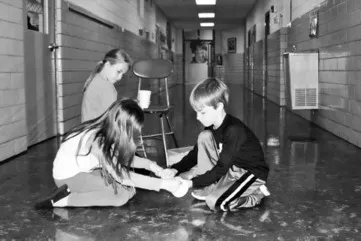
- 160 pages
- English
- ePUB (mobile friendly)
- Available on iOS & Android
STEM-Infusing the Elementary Classroom
About this book
Make learning relevant with STEM essential questions
Planning interdisciplinary STEM lessons that meet K-5 grade level expectations can be a challenge. How do you fit it all in? In this engaging, well-organized guide, STEM instructional trailblazer Miranda Reagan provides a teacher-friendly, research-based guide to quickly and confidently infuse STEM concepts across content areas. Real-world vignettes, sample lessons and templates, discussion questions, and immediately applicable action steps help you seamlessly promote college and career ready skills.
This inspiring guide helps teachers use STEM-infused interdisciplinary instruction to:
- Deepen all content areas, including English/ Language Arts
- Promote the 4Cs: communication, collaboration, critical thinking, and creativity
- Require students to take risks to solve problems
- Differentiate instruction and scaffold support
- Expand students' specific measurable capabilities
- Incorporate design skills into the curricula
Save valuable time and confidently develop standards-aligned STEM projects across all content areas with this breakthrough guide!
"Spirited Teachers Eliciting Memories. Miranda?s book is an inspiration for the elementary teacher who wants to begin using STEM in the classroom." She has answered all of the "but what ifs" and the "I?m not sures" and given teachers the answers to the "hows and whys" it will work."
–Dr. Jill C. Mertz, Adjunct Professor of Education at Maryville College, Maryville, TN
"After reading this book, infusing STEM into your elementary classroom will be as easy as 1,2,3…A, B, C!"
–Susan Schipper, Elementary Teacher, Charles Street School, Palmyra, NJ
Frequently asked questions
- Essential is ideal for learners and professionals who enjoy exploring a wide range of subjects. Access the Essential Library with 800,000+ trusted titles and best-sellers across business, personal growth, and the humanities. Includes unlimited reading time and Standard Read Aloud voice.
- Complete: Perfect for advanced learners and researchers needing full, unrestricted access. Unlock 1.4M+ books across hundreds of subjects, including academic and specialized titles. The Complete Plan also includes advanced features like Premium Read Aloud and Research Assistant.
Please note we cannot support devices running on iOS 13 and Android 7 or earlier. Learn more about using the app.
Information
Chapter 1 STEM-Infusing All Content Areas

A Way of Teaching
- English/Language Arts. Cause and effect
- Math. Triangles
- Social Studies. Branches of government, checks and balances
- Science. Environmental impacts

SOURCE: Photo by Linda Talley.
SOURCE: Photo by Linda Talley.
Misconceptions About Stem-Infusion
- “Oh, you’re integrating arts into STEM….You should really call that STEAM.”
- “Since you’re using STEM to teach reading and arts, that should be labeled STREAM.”
- “Isn’t what you’re really describing more like project-based learning than STEM? I don’t think people in the hard sciences would consider that ‘pure STEM.’”
- “Oh, yeah…. That’s just thematic teaching. That was a fad back when I started teaching before high stakes testing came along. I think it’s funny that the pendulum is starting to swing back toward a thematic approach to teaching again.”
- Creativity is embedded in the engineering design process. Therefore, I do not feel it is essential to include the word “art” in my acronym since I believe art is implied as part of “STEM.”
- STEM-infusion means STEM processes are used to teach or practice all content areas, including reading. Thus, reading falls under the umbrella of the word “infusion.”
- I am definitely not talking about “pure STEM” in this book. I am by no means a scientist, technologist, engineer, or mathematician. In fact, I was extremely intimidated by the idea of STEM when I first heard about it because of my lack of expertise in the complexity of each of those subjects. Now, I hold those subjects in high regard but instead of feeling intimidated by them, I have drawn out some of their most brain-stretching components and processes and combined them to teach elementary school.
- There are some elements of thematic instruction in STEM. In fact, one of the approaches that will be discussed in Chapter 6 is a thematic approach to STEM-integration. However, STEM-infusion takes thematic instruction beyond just connecting ideas by topic; it connects ideas by concepts that show up across content areas and challenges students to combine this conceptual understanding to design a solution to a problem.
Said No One Ever
I really feel I can easily fit everything I need to accomplish into my school day and every student will receive the individualized help he or she needs.—Said No One Ever
Spiraling Down
A Breath of Fresh Air
- •Give students an opportunity to apply information from all content areas, therefore providing a higher-order level of understanding of the curriculum standards.
- •Differentiate organically because each student uses his or her background knowledge and applies it in such a way as to find an innovative solution. In this way, every student is stretched.
- Create a culture where mistakes are seen as an important part of growth and learning.
- •Offer opportunities for students to practice collaboration, communication, creativity, and critical thinking in a w...
Table of contents
- Cover
- Half Title
- Acknowledgements
- Title Page
- Copyright Page
- Contents
- Foreword
- Preface
- Acknowledgments
- About the Author
- Chapter 1 STEM-Infusing All Content Areas
- Chapter 2 Why STEM in Elementary?
- Chapter 3 Rigor Meets Relevance
- Chapter 4 The Cross-Cutting Concepts Approach to STEM-Infusion
- Chapter 5 The Standards Alignment Approach to STEM-Infusion
- Chapter 6 The Thematic Approach to STEM-Infusion
- Chapter 7 Assessing STEM
- Chapter 8 The Benefits of the STEM Mindset: Risk Taking and Resilience
- Chapter 9 Student Collaboration
- Chapter 10 Leadership for Change
- Resources
- Glossary
- References
- Index
- Advertisement